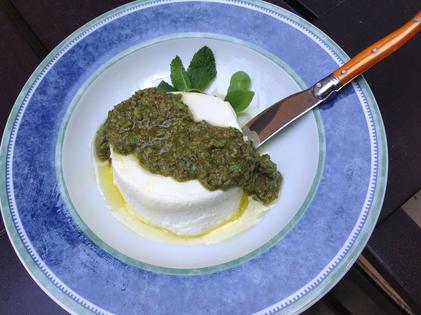Seriously Simple: Fresh ricotta cheese offers comfort, possibilities
The first time I tasted fresh ricotta cheese in the U.S. I was at the book signing of an expert Italian cook. She served ramekins of warm cheese, soft and creamy, drizzled with green olive oil and sprinkled with fresh herbs. I couldn't get over the slightly sweet flavor, smooth texture and beautiful presentation. I was bitten by the ricotta bug! Just a taste of this offers creamy comfort and loads of possibilities.
Fresh homemade ricotta cheese is far superior to the best store-bought variety. You can find whole milk ricotta cheese that is pretty good at the market, but often the cheese is a bit watery. Some experts assign the name of cream cheese to this homemade gem when cream is added to the mixture. I still call it ricotta (which, by the way, means "recooked" in Italian). I tested many recipes from books, cooks and friends and finally came up with the following recipe. You can use fresh lemon juice, but I prefer white vinegar for its clean flavor.
There are a few things to know when making this cheese.
1. For easy cleanup, wash out the saucepan (hopefully non-stick) with cold water to keep milk from sticking on the bottom.
2. It is essential that you NOT use ultra-pasteurized milk, or the cheese recipe will not work.
3. Make sure you have a candy or deep-fry thermometer, cheesecloth and a large strainer with a handle.
4. As the curds drain, the consistency goes from soft to firm, so watch carefully to achieve desired consistency.
I love to embellish this cheese with a bright pesto for a delightful appetizer. You can use your favorite pesto and just add a handful of cooked peas, fresh mint leaves and the zest of a lemon, all blended together, for a perky companion to the decidedly simple-flavored ricotta.
There are also many other possibilities for this basic dish. Consider dolloping the ricotta over sun-dried tomatoes or olive tapenades, or pour an assertive almond romesco sauce over the cheese. But that's just the beginning.
Use this cheese in pastas, on pureed vegetables or even on potatoes. For dessert, serve a ramekin of this drizzled with white truffle honey and garnished with pistachios. Or, serve it with sliced nut bread. As you can see, there are many possibilities for you to be creative with the ways in which you present and eat this cheese.
Fresh Ricotta Cheese
Makes about 1 3/4 cups
1 half-gallon (8 cups) good quality whole milk (do not use ultra-pasteurized)
1/2 cup heavy whipping cream (do not use ultra-pasteurized)
2 teaspoons salt
3 tablespoons white vinegar
1. Line a large strainer with triple strength wet cheesecloth, and place over a bowl large enough to catch any whey. Set aside.
2. Rinse a heavy non-stick 6-quart pot with cold water and then dry. Attach the thermometer to the side of the pan. Add the milk, cream and salt, and place the pan on medium-high heat, stirring frequently, until the temperature is between 170 F and 190 F. Remove from the heat and add the vinegar.
3. Stir a few times and allow the curds to form, about 1 to 2 minutes. Using a slotted spoon transfer the curds into the strainer and let curds drain for at least an hour. As the curds sit, they become firmer, almost like cream cheese. Transfer the ricotta to a bowl and serve immediately or cover well and store in the refrigerator up to three days.
(Diane Rossen Worthington is an authority on new American cooking. She is the author of 18 cookbooks, including "Seriously Simple Parties," and a James Beard Award-winning radio show host. You can contact her at www.seriouslysimple.com.)







